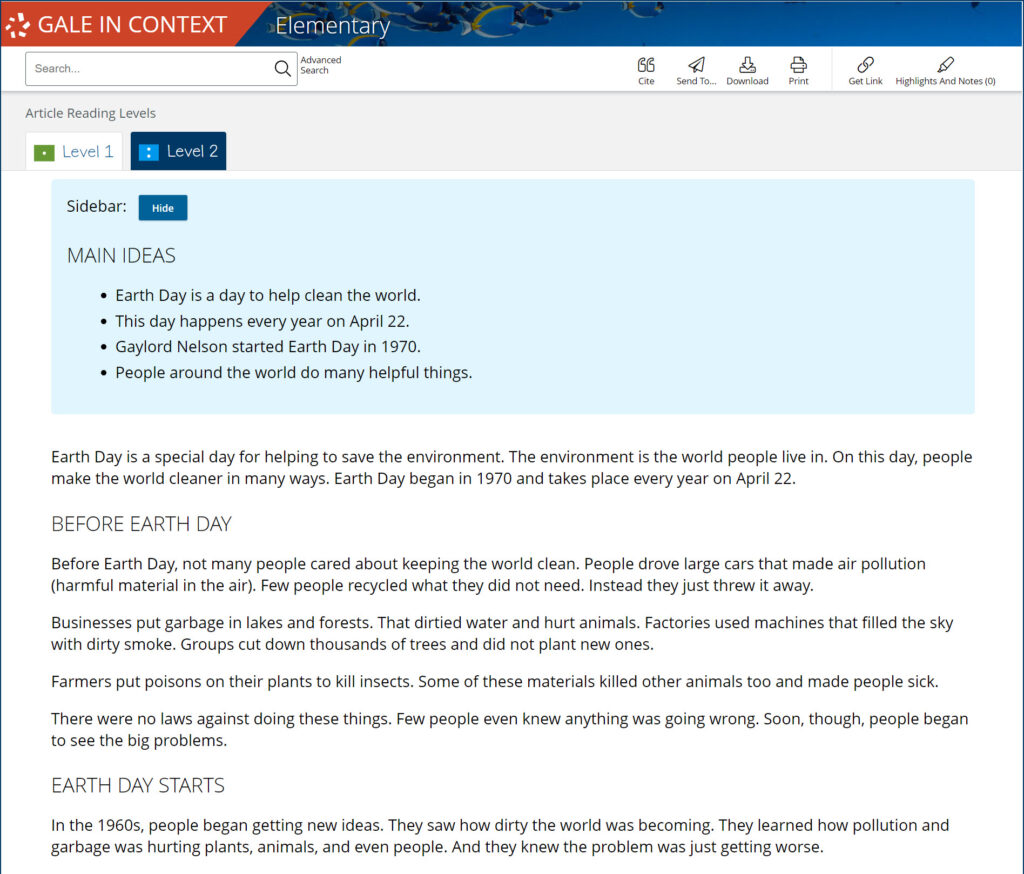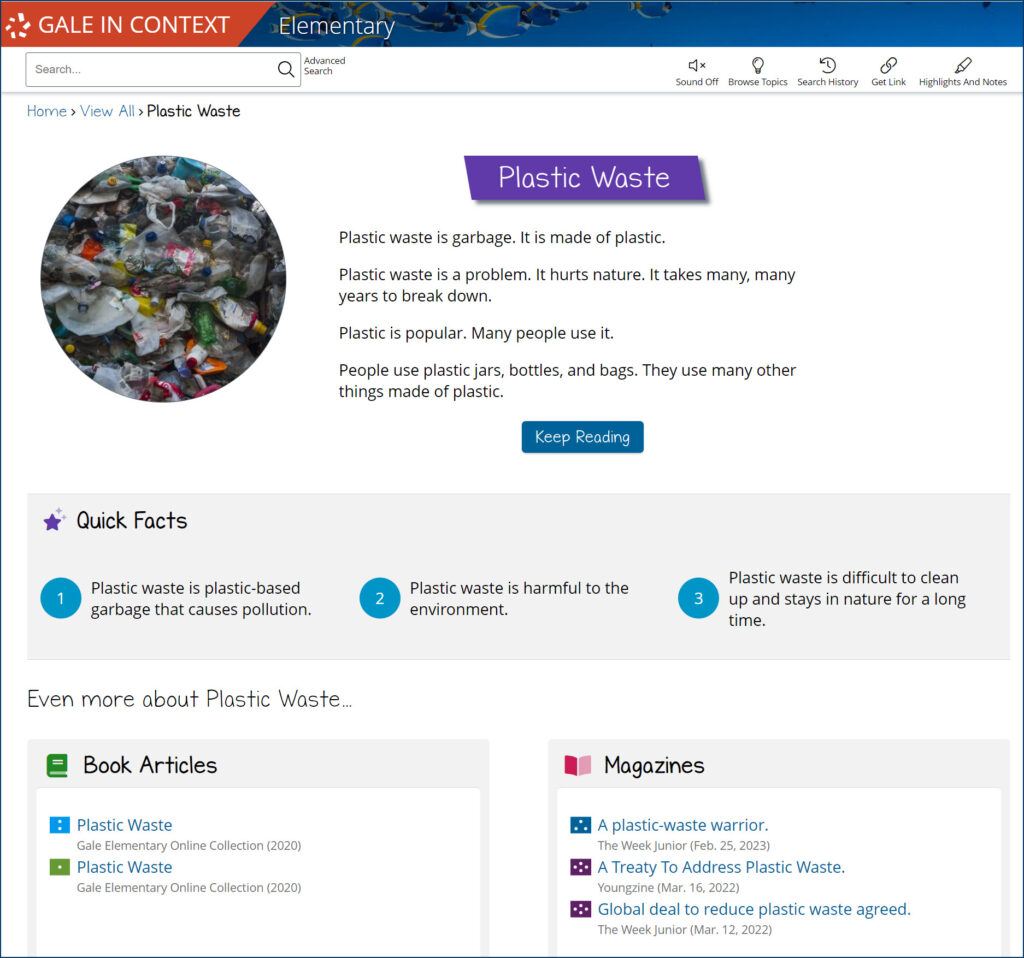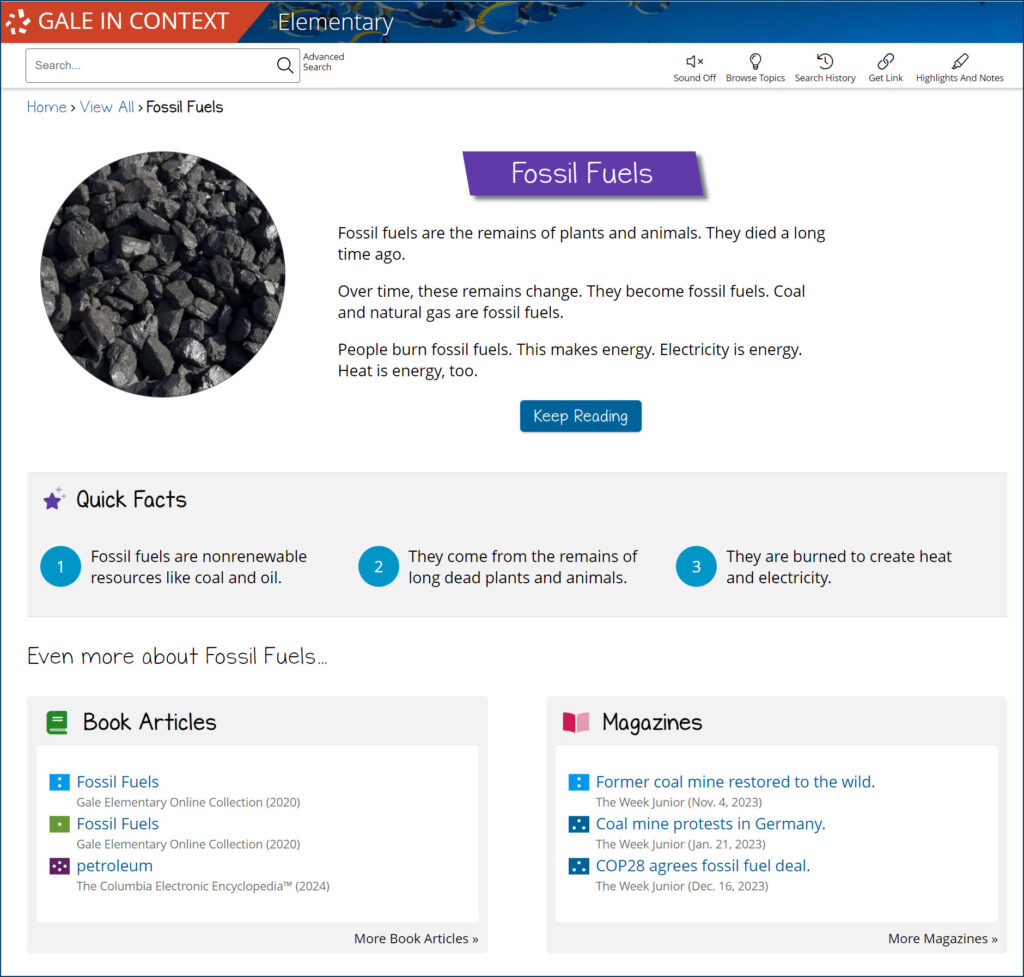| By Gale Staff |
Earth Day lands on April 22 each year. With your students undoubtedly daydreaming about summer plans, Earth Day is a chance to reinvigorate learning and prepare your students to end the year on a high note.
Education about our natural environment is a fun topic—and a powerful catalyst for positive change. Earth Day can teach us important lessons about conservation efforts and sustainable lifestyle choices, which may impact how your students view their environment as adults.
You can turn to Gale In Context: Elementary to support your Earth Day lesson planning. This database is overflowing with kid-friendly news stories, educational videos, podcasts, magazine articles, and guided summaries on relevant Earth Day topics. The breadth of content available in these diverse formats and our embedded customization features provide your students with the tools for independent exploration and active learning. With Gale’s Earth Day collection, you can encourage them to pursue their curiosity about the world around them and consider lifelong habits to help protect it.
Earth Day celebrations encompass many different concepts; after all, there is no one solution to tackle the complicated threats to the planet. The 2024 Earth Day celebration has a special theme: “Planet vs. Plastics.” Organizers are rallying behind the aspiration to reduce global plastic production by 60% by 2040. No matter the direction you take your Earth Day lesson plans, Elementary has related content to engage students and support your classroom goals.
Discuss the Origins of Earth Day
The first Earth Day celebration occurred in 1970. Following several devastating environmental events, including the Cuyahoga River fire and the Santa Barbara oil spill, Senator Gaylord Nelson from Wisconsin sought to raise public concern about environmental pollution. To achieve this initiative, he launched a national campaign to facilitate teach-ins on college campuses (college teach-ins had become a popular tool for the era’s active Vietnam War protests).
Nelson recruited a young, energetic activist named Denis Hayes to spearhead his idea. The event was planned for April 22 to maximize student involvement, as the date strategically fell between spring break travel and final exams. Their hard work and ingenuity paid off: more than 20 million Americans participated in the first Earth Day. Today, over 1 billion people participate in Earth Day observations annually.
Activity Idea: It’s been over 50 years since the founding of Earth Day, and a lot has happened to our planet since. Grab a long piece of butcher paper to create an Earth Day timeline from its founding in 1970 to today. Ask your students to use Gale In Context: Elementary to identify other significant events in environmental history to include on the timeline. Examples include passing the 1973 Endangered Species Act and 1989’s Exxon Valdez oil spill. Have them decorate the finished timeline project, which you can hang along the hallway or in the school library.
Commit to Reducing Classroom Plastic
As mentioned, the 2024 theme for Earth Day is “Planet vs. Plastics,” and you can find an entire portal dedicated to plastic waste in Gale In Context: Elementary.
Plastic is a serious global threat—especially single-use plastics like straws, balloons, and plastic wrap. Only 10% of plastics in the U.S. are recycled, meaning millions of tons of plastic waste end up in landfills and bodies of water each year, harming the surrounding flora and fauna.
To illustrate the extent of the problem, introduce students to information and images of the Great Pacific Garbage Patch, which spans hundreds of miles and is predominantly made from plastic trash. As alarming as these statistics are, there are ways to help reduce plastic use and remove plastic pollution from our oceans. However, large-scale initiatives require significant funding and public support, making it all the more vital to bring awareness to this serious global issue.
Discussion Idea: Direct students to inventory the plastics in your classroom. They’ll discover everything from markers and water bottles to trash bags and desk chairs. Discuss how the class could collectively help reduce plastic waste. For more ideas, EarthDay.org has some great action steps.
Create Strategies to Decrease Your Carbon Footprint
Burning fossil fuels (oil, natural gas, and coal) releases carbon dioxide (CO2) into the atmosphere. While industrial entities shoulder much of the blame, individuals also have a part to play. Most Americans rely on fossil fuels to light and heat their homes, drive to work, and travel. Carbon dioxide from human activities is the number one contributor to climate change. For this reason, reducing global carbon emissions is the most critical step humankind can take to avoid the worst consequences of climate change.
Activity Idea: Earth Day presents an opportunity to reflect on our daily habits. Why not calculate your carbon footprint? According to the Nature Conservancy, the average carbon footprint for a person living in the U.S. is 16 tons—four times larger than the global average. How do you compare? There are plenty of free and easy tools online to help individuals evaluate their personal impact (we like this free carbon calculator from 8 Billion Trees).
Ask students to bring the exercise home and, with help from mom and dad, determine their own carbon footprint. They don’t need to share their number but encourage them to consider what actions could help reduce their overall impact.
When you integrate hands-on activities into your Earth Day lesson plan, your students engage deeper with these subjects. To help you get inspired, we have a teacher-dedicated database called Gale In Context: For Educators that works alongside our student-facing products. We designed this resource to support busy educators with their curriculum planning and professional development targets. The database features tips for personalized student instruction, strategies to improve accessibility for different learners, and tools to track and measure their progress.
This April, leverage your Gale resources to help every student learn something new about our planet and commit to doing their part to protect it. You can help kickstart and motivate the next generation.
If your school isn’t already a Gale subscriber, speak to your local rep to find out more and even request a product trial.




